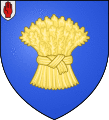Richard Grosvenor Bt | |
|---|---|
| Personal details | |
| Born | 9 January 1585 Eaton Hall, Cheshire, England |
| Died | 14 September 1645 (aged 60) |
| Resting place | St Mary's Church, Eccleston, Cheshire, England |
Sir Richard Grosvenor, 1st Baronet (9 January 1585 – 14 September 1645) was an English politician who sat in the House of Commons at various times between 1621 and 1629. He is an ancestor of the modern day Dukes of Westminster.
Grosvenor was born at Eaton Hall, Cheshire, the only surviving son of 17 children.[1] His father was Richard Grosvenor of Eaton, and his mother was Christian, the daughter of Sir Richard Brooke of Norton Priory, Cheshire.[2] His early education was by John Bruen, a local puritan and at the age of 13 he went to The Queen's College, Oxford.[1] He matriculated in 1599 and graduated BA on 30 June 1602.[3]
Political career
In 1602 Grosvenor was High Sheriff of Cheshire. He was knighted by James I in Vale Royal on 24 August 1617.[1] In 1621 he was elected Member of Parliament for Cheshire. He was created baronet on 23 February 1622. In 1623 he was High Sheriff of Cheshire again and in 1625 High Sheriff of Denbighshire. He was re-elected MP for Cheshire in 1626 and 1628 and sat until 1629 when King Charles decided to rule without parliament for eleven years. His diary-taking has been described as meticulous and it is thought his diary taking represents some of the most complete accounts of Parliamentary debate from the period.
Incarceration
Grosvenor stood surety for the debts of his son-in-law, Peter Daniell, but in 1629 Daniell defaulted on his debts, and for almost ten years Grosvenor was incarcerated in the Fleet Prison.[1]
Grosvenor died in Eaton Hall in 1645 and was buried in Eccleston Church.[2]
Family
Grosvenor married three times. His first marriage was in 1600 to Lettice Cholmondley, daughter of Sir Hugh Cholmondeley of Cholmondeley, Cheshire. With her he had a son and three daughters. Lettice died in 1612 and two years later he married Elizabeth Wilbraham, the daughter of Sir Thomas Wilbraham of Woodhey, Cheshire.[2] Following her death in 1621 he married Elizabeth Warburton, daughter and sole heiress of Sir Peter Warburton of Grafton, also in Cheshire.[1] His third wife died in 1627.[2] He was succeeded in the baronetcy by his son Sir Richard Grosvenor, 2nd Baronet.[1]
St Mary's Church, Eccleston – The enclosure which marks the site of the Grosvenor family vault within the demolished old church
St Mary's Church, Eccleston – The tablet in the enclosure marking the site of the Grosvenor family vault within the old church
St Mary's Church, Eccleston – The tablet in the new church which lists the Grosvenors buried in the demolished old church
External links
References
- ^ a b c d e f Newton, Diana; Lumby, Jonathan (2002), The Grosvenors of Eaton, Eccleston, Cheshire: Jennet Publications, pp. 3–7, ISBN 0-9543379-0-5
- ^ a b c d Cust, Richard (2004) 'Grosvenor, Sir Richard, first baronet (1585–1645)', Oxford Dictionary of National Biography, Oxford University Press, Retrieved on 6 April 2010. (subscription or UK public library membership required)
- ^ 'Alumni Oxonienses, 1500–1714: Greenhill-Gysby', Alumni Oxonienses 1500–1714: Abannan-Kyte (1891), pp. 600–625. Date accessed: 28 November 2011
| Parliament of England | ||
|---|---|---|
| Preceded by Sir William Brereton Sir Roger Wilbraham | Member of Parliament for Cheshire 1621–1624 With: Sir William Brereton | Succeeded by William Booth William Brereton |
| Preceded by Sir Robert Cholmondeley, Bt Sir Anthony St John | Member of Parliament for Cheshire 1626–1629 With: Peter Daniell 1626 Sir William Brereton, Bt 1628–1629 | Succeeded by Parliament suspended until 1640 |
| Baronetage of England | ||
| New creation | Baronet (of Eaton) 1622–1645 | Succeeded by Richard Grosvenor |

